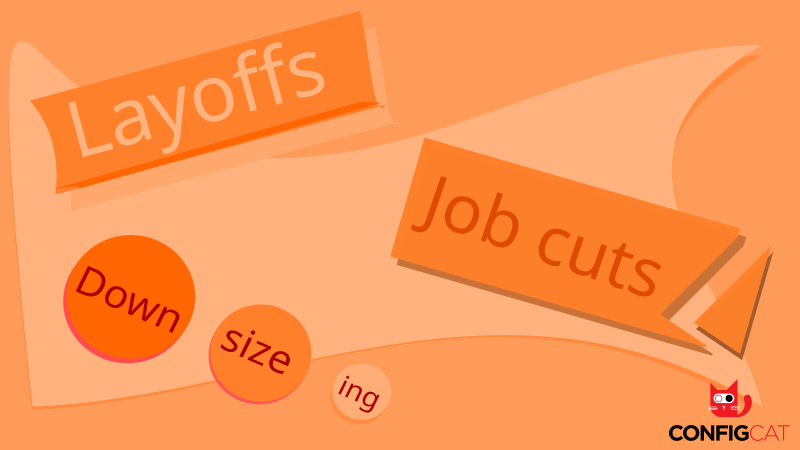Reducing the Impact of Layoffs with Feature Flags
As you might have heard by now, the tech world is undergoing massive layoffs due to the looming recession. Big tech companies like Twitter, Meta, Google, and Amazon have all announced massive job cuts in the past few months. Software developers are on the receiving end in 2023, accounting for 20% of layoffs, according to data from workforce intelligence firm Revelio Labs.
Apart from the stress and anxiety it causes employees who were let go, layoffs can disrupt the rhythm of development teams and impact how projects move forward. The developers that survive layoffs are expected to keep everything running smoothly despite their smaller numbers. They'll have to explore strategies that will allow them to continue working efficiently and produce high-quality software without overworking themselves.

Effects of Layoffs on Software Development Teams
Shifting Projects and Priorities
When a company experiences layoffs, they need to take a step back and reevaluate their goals. They may need to shift their resources to focus on urgent matters and put certain projects on hold or cancel them altogether. To prioritize the most important features for users, they may need to adjust the scope of their projects. They may need to delay working on advanced or less critical features until their developers have time to pick them up.
Loss of Knowledge
When employees leave, their expertise and deep knowledge about the software they build also leave with them. The remaining developers might take much longer to solve problems because they don’t know as much as the former employees do. They will have to learn a lot of things in order to operate at desired levels. Having well-documented software will help in this case, but it is not the same as having an expert on hand.
Increased Anxiety
Besides the technical hurdles, the emotional toll of layoffs is a pressing concern. Developers may experience significant stress due to job stability concerns and increased workloads. They might have to take on tasks that require a whole new set of skills than the ones they have. This anxiety and uncertainty can harm their well-being and quickly lead to burnout, which can ultimately impact the overall performance of the software development process.
With all these new challenges, development teams need effective strategies to manage their situation. While there is no single solution to these problems, they can get more control and organization over the software they build by using feature flags.
What are Feature Flags and How Can They Help?

Feature flags, also known as feature toggles, are tools that enable teams to activate or deactivate specific features in an application without redeploying code. This flexibility empowers teams to efficiently manage the availability and presentation of features and create personalized experiences through user targeting and segmentation. This makes them a good choice for conducting A/B testing, beta and canary releases, infrastructure migrations, and more. Their wide range of use cases makes them valuable to non-development teams like sales, marketing, and technical support.
Here are a few ways in which feature flags can ease the challenges layoffs bring to software development:
Progressive Delivery
Feature flags allow teams to release new features gradually to a subset of users. This approach can help them avoid sudden disruptions and lets them monitor the performance of new features. They can collect user feedback and continuously refine the features until they're fully ready to be rolled out to all users. This gradual, iterative development process with tight feedback loops will reduce the strain on the remaining workforce.
Strategic Prioritization
Working with limited resources, organizations will need to identify the features that offer greater business value and direct their efforts to them. Using feature flags, their developers can prioritize some features over others.
Consider this scenario: an e-commerce company is experiencing layoffs while developing two major features - an advanced recommendation engine and a loyalty rewards program. Since they now have fewer employees, they can no longer work on both features at the same time. They eventually prioritize the loyalty rewards program as it aligns more closely with their business objectives.
They pause the development of the recommendation engine by wrapping it with a feature flag and turning the feature off. Using progressive delivery, they slowly release the loyalty rewards feature to a limited group of users, collect feedback from them, and gradually improve it. Once the feature is ready, they can roll it out to all users.
Mitigating Risk
Introducing new features and changes in software can sometimes trigger unforeseen issues despite intensive testing. The tendency to introduce bugs becomes higher if developers with more knowledge of the software get laid off. As the remaining developers build new features and maintain existing ones, they'll need to quickly handle any issues that arise to avoid negative user experiences.
Using feature flags, they can instantly turn off a buggy feature when they receive complaints about it from users. The rest of the software won't be affected and will continue to work normally. In the meantime, they can focus on fixing the bug, and when they're done, they can turn the feature back on and notify users of the fix.
Experimentation
With feature flags, organizations can easily conduct A/B tests and similar experiments by serving different variations of features to their users. This can be particularly valuable during challenging times, as it enables them to make data-driven decisions about the features that are having a positive impact and those that need further improvement.
Another advantage of using feature flags for experiments is that the teams that usually run these experiments, like marketing and analytics, can have control of feature flags instead of going through developers whenever they need to use them. With feature flags empowering people outside development teams, developers can better focus on their jobs and reduce their workloads.
User-Centric Development
The world of software users is incredibly diverse, with individuals having unique preferences, behaviors, cultures, and geographical locations. Taking a one-size-fits-all approach to software features isn't usually the best option for such a diverse range of users. This is where user segmentation comes into play. Based on what organizations know about their users, they can create user segments and use feature flags to serve them features that directly meet their needs. Users will feel more satisfied using features that are tailor-made for them instead of getting bundles of generic features that they may never use.
Collaboration and Visibility
Collaboration is a key ingredient in software development, requiring the input of individuals from various teams within an organization. Feature flags can enhance collaboration, as they allow different teams to use them for multiple purposes, ultimately leading to more efficient software development and management.
Dedicated Feature management platforms like ConfigCat can enhance the use of feature flags by providing a centralized location for teams to manage, organize, and monitor their flags. Information can be added to feature flags in ConfigCat, making it easy for everyone to see which features they affect and who is responsible for them. Audit logs are also available, providing teams with valuable insights into who toggled a flag and when.
ConfigCat also offers user targeting and segmentation features for conducting A/B tests, canary releases, and other progressive rollout strategies. Using feature management platforms, software development teams can maintain transparency throughout the development process, making it easier to share progress, insights, and updates.
Key Takeaways
Tech companies who reduce their workforce have to put in measures to ensure that their software products continue working smoothly while not putting strain on their employees. By harnessing the potential of feature flags, companies can achieve a smoother transition through layoffs, enabling teams to adapt and innovate during challenging times.
To quickly recap, feature flags can help organizations to:
- Gradually roll out features to users.
- Prioritize features to work on when they have less resources.
- Minimize the impact of bugs.
- Quickly respond to user feedback.
- Focus on developing customized features for different user groups using segmentation.
- Make data-driven decisions about feature improvements using experiments.
- Improve collaboration between cross-functional teams.
If you or your organization wants to get started with feature flags, you should check out ConfigCat's feature flag service. ConfigCat has a forever free plan with enough features for low-volume use cases. You can sign up for the free plan to get started or schedule a personalized demo with their team to walk you through the product and get the answers to any questions you have. Deploy any time, release when confident.
Stay connected to ConfigCat on Facebook, X (Twitter), LinkedIn, and GitHub.
